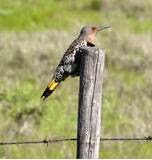Brrrrr...... it's suddenly so cold out there! So glad I filled the bird feeders yesterday while it was still beautifully snowy but not frigidly cold.
With the arrival of the cold weather I thought that now might be a good time for a few quick tips on how to feed the birds to help them survive a cold winter.
Winter bird feeding tips:
1) Stock those feeders! Birds need lots of calories to keep warm on cold winter days. Provide food that has the maximum bang for the calorie buck:
2) Regularly fill your feeders! Now that the birds have found your backyard and are relying on your help to survive the cold, it's important to keep the food coming.
3) Put up a few different types of feeders in your yard. This will spread the birds out and reduce competition at your feeders.
4) Keep the feeders clean of snow. Snow on the feeder just blocks the seed holes and leads to seed spoilage if and when the snow melts, so try to keep your feeders brushed off.
5) Keep your feeders clean of mess. Some birds are very susceptible to salmonella. Bird droppings on the feeder and around the feeder can help spread this sickness from one bird to another especially when you have lots of birds at your feeders.
Those are a few tips for the day. Happy winter bird feeding!
Kelly
With the arrival of the cold weather I thought that now might be a good time for a few quick tips on how to feed the birds to help them survive a cold winter.
Winter bird feeding tips:
1) Stock those feeders! Birds need lots of calories to keep warm on cold winter days. Provide food that has the maximum bang for the calorie buck:
- Black oil sunflower chips (sometimes called sunflower kernels or hearts) have a high fat content that can help power little birds on those cold winter days. The fact that the sunflower shell has been removed means that the food takes less effort to consume which can also help.
- Skinless peanuts have a high calorie and fat content which is important for birds in the winter time.
- Suet (beef kidney fat that has been specially prepared) is another great energy source for birds on cold winter days.
2) Regularly fill your feeders! Now that the birds have found your backyard and are relying on your help to survive the cold, it's important to keep the food coming.
3) Put up a few different types of feeders in your yard. This will spread the birds out and reduce competition at your feeders.
4) Keep the feeders clean of snow. Snow on the feeder just blocks the seed holes and leads to seed spoilage if and when the snow melts, so try to keep your feeders brushed off.
5) Keep your feeders clean of mess. Some birds are very susceptible to salmonella. Bird droppings on the feeder and around the feeder can help spread this sickness from one bird to another especially when you have lots of birds at your feeders.
Those are a few tips for the day. Happy winter bird feeding!
Kelly





